"When you reach the end of your rope, tie a knot and hang on."
— Anonymous
Rope Overview
When you are looking to choose a rope for bondage, there are 3 important things to know before you can select the type that fits you best. These are:
1. The make- how the rope was prepared
2. The material- what it is made of
3. The diameter of the rope- how thick and heavy the rope is
There are, of course, other influencing factors like the price; whether you can cut the rope to the right length, if the rope is finished or needs finishing, if it is washable, and so on. All of these concerns play a role when it comes to choosing, but you should make your decision primarily based on how you plan on using the rope. So let's look at the various advantages and disadvantages of the different types of rope!
1. The make- how the rope was prepared
2. The material- what it is made of
3. The diameter of the rope- how thick and heavy the rope is
There are, of course, other influencing factors like the price; whether you can cut the rope to the right length, if the rope is finished or needs finishing, if it is washable, and so on. All of these concerns play a role when it comes to choosing, but you should make your decision primarily based on how you plan on using the rope. So let's look at the various advantages and disadvantages of the different types of rope!
The Make
To begin with, there are two main types of bondage rope: twisted and braided. Let's begin by looking at these two types of rope before we break it down further.
Twisted Rope
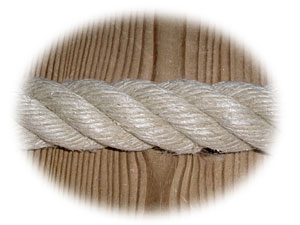
This is how the traditional Japanese Shibari ropes were, and still are, prepared. This type of rope is usually made of long vegetable fibers that are worked into yarns strands. Three of these strands are secured together, and then they are simultaneously, but individually, twirled in one direction. This creates a tension that will eventually make the yarns twist around each other - in the opposite direction of twirling.
The surface of the twisted strands is less smooth than that of the braided variety rope, but whether the twisted rope is actually rough or not depends on the material the rope is made of. Twisted ropes can bite into the skin and if they are left pressed against the skin for an extended period of time they can leave a diagonal impression in the skin. If the rope is made of a softer, silkier material (like silk) you have to be careful handling the rope as the twisted strands could slide along each other and cause the rope to unravel in the middle.
Braided Rope
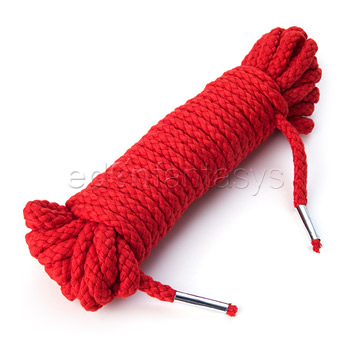
This type of rope is braided with twisted strands of material or untwisted strands of material. This type of rope has many different types. For instance; the rope can have a core of material that is the same as the outer covering or different than the outer covering. The braided rope can have an inner core of thinner braided rope, called “braid on braid”, that is rather expensive and very durable.
The braided rope can also have no core leaving the resulting rope tightly woven. This is called a “solid braid” and it is very rough and firm. There is also a type of braided rope, called “hollow braid rope”, that has a hole where the core should be.
In many cases bondage players remove the core from their ropes to create a much softer, hollow core version. Braided ropes are easier to handle, slide more smoothly and they are easier to work into knots. They don’t bite into the skin as much as twisted strand ropes and they are softer against the skin, but they often do not look as authentic as the twisted strand ropes. The braided ropes don’t leave the exciting impressions patterns on the skin that enthusiasts of Japanese Shibari enjoy.
It is worth finding a proper bondage rope as most ropes sold in stores are unsuitable for bondage because they are too thin or not strong enough.
Twisted Rope

This is how the traditional Japanese Shibari ropes were, and still are, prepared. This type of rope is usually made of long vegetable fibers that are worked into yarns strands. Three of these strands are secured together, and then they are simultaneously, but individually, twirled in one direction. This creates a tension that will eventually make the yarns twist around each other - in the opposite direction of twirling.
The surface of the twisted strands is less smooth than that of the braided variety rope, but whether the twisted rope is actually rough or not depends on the material the rope is made of. Twisted ropes can bite into the skin and if they are left pressed against the skin for an extended period of time they can leave a diagonal impression in the skin. If the rope is made of a softer, silkier material (like silk) you have to be careful handling the rope as the twisted strands could slide along each other and cause the rope to unravel in the middle.
Braided Rope

This type of rope is braided with twisted strands of material or untwisted strands of material. This type of rope has many different types. For instance; the rope can have a core of material that is the same as the outer covering or different than the outer covering. The braided rope can have an inner core of thinner braided rope, called “braid on braid”, that is rather expensive and very durable.
The braided rope can also have no core leaving the resulting rope tightly woven. This is called a “solid braid” and it is very rough and firm. There is also a type of braided rope, called “hollow braid rope”, that has a hole where the core should be.
In many cases bondage players remove the core from their ropes to create a much softer, hollow core version. Braided ropes are easier to handle, slide more smoothly and they are easier to work into knots. They don’t bite into the skin as much as twisted strand ropes and they are softer against the skin, but they often do not look as authentic as the twisted strand ropes. The braided ropes don’t leave the exciting impressions patterns on the skin that enthusiasts of Japanese Shibari enjoy.
It is worth finding a proper bondage rope as most ropes sold in stores are unsuitable for bondage because they are too thin or not strong enough.
The Material
The materials that proper bondage ropes are made of can be divided into two basic groups: Natural Materials and Synthetic Materials.
Natural materials
The most commonly used natural materials are jute, hemp, and cotton, but more exotic ropes can be purchased too.
Manila (untreated hemp), sisal (agave fiber) and coir (coconut husk fiber) ropes are also natural, but they are unsuitable for bondage as the fibers are too hard, rough and can leave splinters in the skin.
Natural rope may cause an allergic reaction in some users so before deciding to use ropes of this type be sure to test if they are safe for your, or your partner’s, skin. You can take a very small length of the rope and curl it into the bend of your elbow, to test for any reaction. Hold it for up to 15 minutes and then carefully look at your skin to see if you notice any itching, redness or swelling in the area.
•Jute
This is the traditional Japanese bondage rope material used for shibari. It is made of fibers extracted from the bark of the jute (corchorus) plant . It is commonly produced in Japan, but is fairly hard to find in the United States or Europe. Most bondage players in the US and Europe use hemp instead of jute even though jute produces a rope that is lighter, smoother and has a different scent from hemp rope.
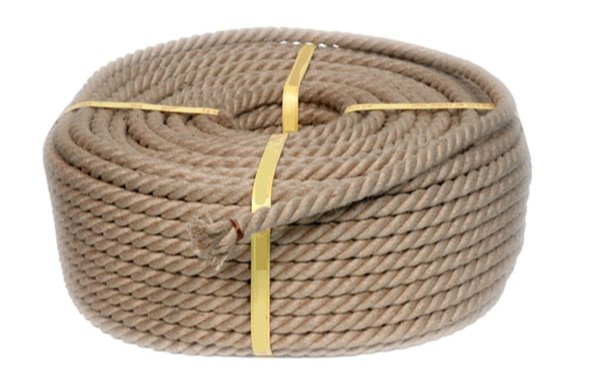
•Hemp
This rope material is prepared from the Cannabis sativa L plant, and it is an extremely strong and durable rope. It is available raw or finished. The raw hemp rope is not suitable for bondage. To be suitable for bondage raw hemp rope needs to undergo a finishing process which takes a long time and includes boiling, sanding and oiling- among other things.
This type of rope is stronger and heavier than jute, and has more stretch, and provides an authentic Japanese feel and look. It is highly abrasive, which prevents struggling, but rubbing it against the skin can leave rope burns. Knots can be tight and secure, however, hemp is prone to fraying and breaking. Repeated washing softens the rope, but it is really not suitable for frequent washing. It is easily cut.
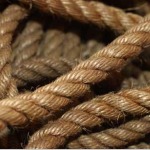
•Linen
It is prepared from the flax plant. It feels very different from hemp and jute. It is a lot softer, is "fluffier" and it lacks the distinctive smell of either jute or hemp. It holds knots well, and has little stretch. Linen is not commonly used for bondage rope but it is perfectly suitable.

•Cotton
While cotton might look a bit “amateur” next to the other types of ropes available, it has some advantages. It is cheap, and available in most grocery stores. If you need a rough and/or stiff rope, cotton rope can be perfect just out of the package. It has a narrow gauge, and a non-slip texture which makes secure, tight knots and allows the rope to bite, pleasantly, into the skin. With repeated washings it softens considerably. It is easy to cut, and since it is very cheap you don’t need to worry about messing up more expensive rope. It has a distinctive stretch, though, so it can make the knots hard to undo. It does have a lower tensile strength than the other types of rope, which makes cotton rope unsuitable for suspension. It is soft on the skin and therefore less likely to cause abrasions.
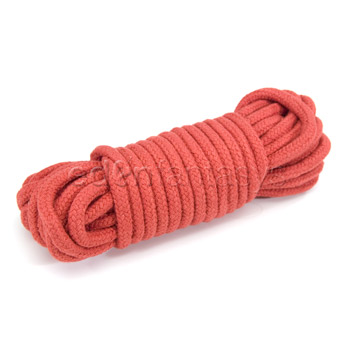
•Bamboo
At first glance bamboo looks like a synthetic rope; white, extremely light, but when you touch it you will feel the difference at once. It is soft and supple without the burning feeling of a synthetic fiber. As bamboo fibers are known for their anti-bacterial properties this is ideal for “messy” bondage such as a crotch-rope. It can be washed in a washing machine like bamboo socks. The only downside is the price.
•Silk
Silk fibers are some of the strongest natural materials on Earth, so these ropes will be durable and able to support great weight. Silk rope is good for suspension. It also feels silky and soft against the skin, and leaves no burns. During the first few uses they can be a bit stretchy and they are pricy.
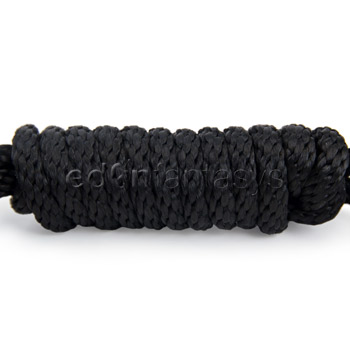
Synthetic materials
The most commonly used synthetic material is nylon, but rayon and dacron are absolutely up for the job too. Kevlar is also suitable for this purpose - if you can afford it.
•Nylon
It is used commonly because it feels soft and silky on the skin, but it can cause rope burns very easily. It comes twisted or braided and the feel is most like that of cotton. It has a high tensile strength, and the knots are easy to undo even after a lot of strain. Nylon, however, does not hold knots as well as the natural fiber ropes, so often double safety knots are needed for suspension play. It is very useful for water bondage as it does not shrink. It stretches a lot, and can absorb sudden loads. It is fairly cheap, easily available and the ends of the rope can be flame-melted to prevent raveling.

•Rayon
It has the same advantages and disadvantages as nylon, but is more durable. It is commonly used in sailing. This type of rope is much more expensive than the nylon varieties.
•Dacron (polyester)
It is not as strong and elastic as nylon, but otherwise very similar. It can be found in handcrafting stores in a variety of colors.
•Kevlar
It is made of a material that is stronger than steel and is very expensive. Usually this type of rope is out of the price range of most bondage enthusiasts.
These materials work well for bondage rope, but parachute cord is too thin and most climbing rope is too thick for bondage purposes. Polypropylene rope is too scratchy on the skin and does not hold knots well.
Natural materials
The most commonly used natural materials are jute, hemp, and cotton, but more exotic ropes can be purchased too.
Manila (untreated hemp), sisal (agave fiber) and coir (coconut husk fiber) ropes are also natural, but they are unsuitable for bondage as the fibers are too hard, rough and can leave splinters in the skin.
Natural rope may cause an allergic reaction in some users so before deciding to use ropes of this type be sure to test if they are safe for your, or your partner’s, skin. You can take a very small length of the rope and curl it into the bend of your elbow, to test for any reaction. Hold it for up to 15 minutes and then carefully look at your skin to see if you notice any itching, redness or swelling in the area.
•Jute
This is the traditional Japanese bondage rope material used for shibari. It is made of fibers extracted from the bark of the jute (corchorus) plant . It is commonly produced in Japan, but is fairly hard to find in the United States or Europe. Most bondage players in the US and Europe use hemp instead of jute even though jute produces a rope that is lighter, smoother and has a different scent from hemp rope.

•Hemp
This rope material is prepared from the Cannabis sativa L plant, and it is an extremely strong and durable rope. It is available raw or finished. The raw hemp rope is not suitable for bondage. To be suitable for bondage raw hemp rope needs to undergo a finishing process which takes a long time and includes boiling, sanding and oiling- among other things.
This type of rope is stronger and heavier than jute, and has more stretch, and provides an authentic Japanese feel and look. It is highly abrasive, which prevents struggling, but rubbing it against the skin can leave rope burns. Knots can be tight and secure, however, hemp is prone to fraying and breaking. Repeated washing softens the rope, but it is really not suitable for frequent washing. It is easily cut.

•Linen
It is prepared from the flax plant. It feels very different from hemp and jute. It is a lot softer, is "fluffier" and it lacks the distinctive smell of either jute or hemp. It holds knots well, and has little stretch. Linen is not commonly used for bondage rope but it is perfectly suitable.

•Cotton
While cotton might look a bit “amateur” next to the other types of ropes available, it has some advantages. It is cheap, and available in most grocery stores. If you need a rough and/or stiff rope, cotton rope can be perfect just out of the package. It has a narrow gauge, and a non-slip texture which makes secure, tight knots and allows the rope to bite, pleasantly, into the skin. With repeated washings it softens considerably. It is easy to cut, and since it is very cheap you don’t need to worry about messing up more expensive rope. It has a distinctive stretch, though, so it can make the knots hard to undo. It does have a lower tensile strength than the other types of rope, which makes cotton rope unsuitable for suspension. It is soft on the skin and therefore less likely to cause abrasions.

•Bamboo
At first glance bamboo looks like a synthetic rope; white, extremely light, but when you touch it you will feel the difference at once. It is soft and supple without the burning feeling of a synthetic fiber. As bamboo fibers are known for their anti-bacterial properties this is ideal for “messy” bondage such as a crotch-rope. It can be washed in a washing machine like bamboo socks. The only downside is the price.
•Silk
Silk fibers are some of the strongest natural materials on Earth, so these ropes will be durable and able to support great weight. Silk rope is good for suspension. It also feels silky and soft against the skin, and leaves no burns. During the first few uses they can be a bit stretchy and they are pricy.

Synthetic materials
The most commonly used synthetic material is nylon, but rayon and dacron are absolutely up for the job too. Kevlar is also suitable for this purpose - if you can afford it.
•Nylon
It is used commonly because it feels soft and silky on the skin, but it can cause rope burns very easily. It comes twisted or braided and the feel is most like that of cotton. It has a high tensile strength, and the knots are easy to undo even after a lot of strain. Nylon, however, does not hold knots as well as the natural fiber ropes, so often double safety knots are needed for suspension play. It is very useful for water bondage as it does not shrink. It stretches a lot, and can absorb sudden loads. It is fairly cheap, easily available and the ends of the rope can be flame-melted to prevent raveling.

•Rayon
It has the same advantages and disadvantages as nylon, but is more durable. It is commonly used in sailing. This type of rope is much more expensive than the nylon varieties.
•Dacron (polyester)
It is not as strong and elastic as nylon, but otherwise very similar. It can be found in handcrafting stores in a variety of colors.
•Kevlar
It is made of a material that is stronger than steel and is very expensive. Usually this type of rope is out of the price range of most bondage enthusiasts.
These materials work well for bondage rope, but parachute cord is too thin and most climbing rope is too thick for bondage purposes. Polypropylene rope is too scratchy on the skin and does not hold knots well.
Featured Product
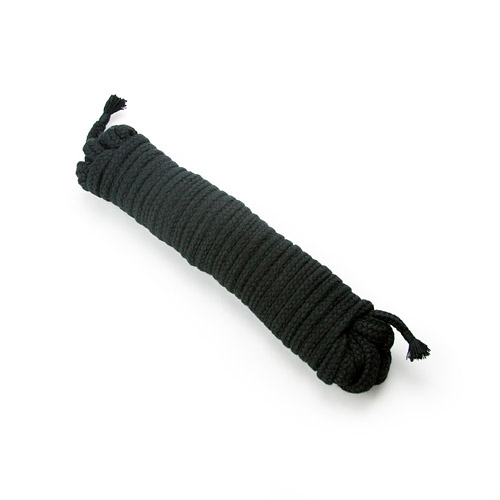
There are so many naughty (knotty) things you can do with this rope. Believe me, I was soaking wet as I thought about the many possibilities. – DancerKittyKat
The Diameter
In bondage rope there are,usually,3 different thicknesses used: 4 mm, 6 mm, 8mm (1/6 inch, 1/4 inch, 1/3 inch). The smaller the diameters of the rope the more pressure it puts on the specific area; much like nylon shopping bags. The same weight in the smaller cheaper bags cuts into your palm more, as it is distributed on a smaller area. The big bags have wider handles which hurt less when you carry them. So if you want to use smaller diameter rope you will need to add more length to the binding in order to avoid hurting your partner. In other words, if you want to use thinner rope you will need a longer piece.
On the other hand, thinner ropes can be tied into more secure and nicer looking knots. Thicker ropes make less comfortable, more bulky knots that untie easily. The thinnest ropes are usually reserved for decorative work like bondage on fingers, toes, hair, face, male genitals or for tying different pieces of rope works together like tying the arm cuffs to the rope body harness. Working with thinner rope requires more attention as you could accidentally cut the blood flow to the limbs fairly easily.
The middle diameter ropes are the most versatile of all the ropes: from harnesses to cuffs and hair, you can use it for pretty much anything. Thicker, and stronger ropes are good for suspension and heavy muscle bondage, but the knots have to be secured extremely carefully as they are more likely to untangle by accident.
The length of rope you need depends a lot on the person you want to tie up and also on the purpose of the bondage: is this a harness or are you just restraining a limb?
In the end it all boils down to personal taste and preference. It might take more than one try to find "the rope" that works best for whatever situation you enjoy the most, but in the meantime, have fun experimenting!
On the other hand, thinner ropes can be tied into more secure and nicer looking knots. Thicker ropes make less comfortable, more bulky knots that untie easily. The thinnest ropes are usually reserved for decorative work like bondage on fingers, toes, hair, face, male genitals or for tying different pieces of rope works together like tying the arm cuffs to the rope body harness. Working with thinner rope requires more attention as you could accidentally cut the blood flow to the limbs fairly easily.
The middle diameter ropes are the most versatile of all the ropes: from harnesses to cuffs and hair, you can use it for pretty much anything. Thicker, and stronger ropes are good for suspension and heavy muscle bondage, but the knots have to be secured extremely carefully as they are more likely to untangle by accident.
The length of rope you need depends a lot on the person you want to tie up and also on the purpose of the bondage: is this a harness or are you just restraining a limb?
In the end it all boils down to personal taste and preference. It might take more than one try to find "the rope" that works best for whatever situation you enjoy the most, but in the meantime, have fun experimenting!


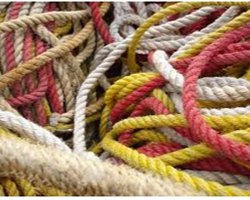

Comments